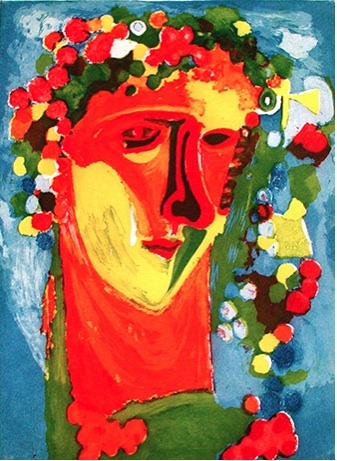 Sorry to interrupt my series on Camp Schramsberg but I just wanted to let you wonderful wine lovers know about a little giveaway we're doing this week.As many of you already know, next Wednesday, October 16th we're kicking off "The Art of Wine" series at The Boca Raton Museum of Art and this week I'm happy to report we'll be giving away two tickets to Wednesday's event - an $80 value! A winner will be selected at random and announced this Sunday, October 13th at 5pm on our Facebook page. Please continue reading to find out how to enter.Each month from October through March "The Art of Wine" will feature fabulous wines paired with the museum's permanent collections. Next Wednesday's event entitled "Southwestern Allure" will feature the wines of Gruet Winery in New Mexico paired with the art of the Santa Fe Art Colony. Gruet has become very well known for producing delicious, award winning sparkling wines. Their Blanc de Noirs was featured as wine #43 in Wine Spectator's Top 100 Wines of the Year! They also make delicious still wines and on Wednesday you'll have the opportunity to taste a variety of Gruet's offerings paired with delicious cheeses from The Cheese Course, our culinary sponsor for the season. Wine, art & cheese - what's not to love about that? As if that weren't enough, following the tasting you'll be able to enjoy a curated tour of the exhibition given by Marisa Pascucci, Curator of 20th Century and Contemporary Art.To enter to win two tickets to the tasting, simply tell me what wine region you'd like to learn more about in the comment section below. Whether it's Greece, Sicily, or even Virginia - you tell me! Each suggestion counts as one chance to win and to get another chance, click on over to our Facebook page by clicking here and give us a "like." You must first enter your comment below though. A winner will be drawn at random on Sunday, October 13th at 5pm and announced on our Facebook page. Best of luck and hope to see you on Wednesday for our inaugural event. For more information on "The Art of Wine" and/or to purchase tickets, please click here.Cheers,
Sorry to interrupt my series on Camp Schramsberg but I just wanted to let you wonderful wine lovers know about a little giveaway we're doing this week.As many of you already know, next Wednesday, October 16th we're kicking off "The Art of Wine" series at The Boca Raton Museum of Art and this week I'm happy to report we'll be giving away two tickets to Wednesday's event - an $80 value! A winner will be selected at random and announced this Sunday, October 13th at 5pm on our Facebook page. Please continue reading to find out how to enter.Each month from October through March "The Art of Wine" will feature fabulous wines paired with the museum's permanent collections. Next Wednesday's event entitled "Southwestern Allure" will feature the wines of Gruet Winery in New Mexico paired with the art of the Santa Fe Art Colony. Gruet has become very well known for producing delicious, award winning sparkling wines. Their Blanc de Noirs was featured as wine #43 in Wine Spectator's Top 100 Wines of the Year! They also make delicious still wines and on Wednesday you'll have the opportunity to taste a variety of Gruet's offerings paired with delicious cheeses from The Cheese Course, our culinary sponsor for the season. Wine, art & cheese - what's not to love about that? As if that weren't enough, following the tasting you'll be able to enjoy a curated tour of the exhibition given by Marisa Pascucci, Curator of 20th Century and Contemporary Art.To enter to win two tickets to the tasting, simply tell me what wine region you'd like to learn more about in the comment section below. Whether it's Greece, Sicily, or even Virginia - you tell me! Each suggestion counts as one chance to win and to get another chance, click on over to our Facebook page by clicking here and give us a "like." You must first enter your comment below though. A winner will be drawn at random on Sunday, October 13th at 5pm and announced on our Facebook page. Best of luck and hope to see you on Wednesday for our inaugural event. For more information on "The Art of Wine" and/or to purchase tickets, please click here.Cheers,
 Sorry to interrupt my series on Camp Schramsberg but I just wanted to let you wonderful wine lovers know about a little giveaway we’re doing this week.
Sorry to interrupt my series on Camp Schramsberg but I just wanted to let you wonderful wine lovers know about a little giveaway we’re doing this week.
As many of you already know, next Wednesday, October 16th we’re kicking off “The Art of Wine” series at The Boca Raton Museum of Art and this week I’m happy to report we’ll be giving away two tickets to Wednesday’s event – an $80 value! A winner will be selected at random and announced this Sunday, October 13th at 5pm on our Facebook page. Please continue reading to find out how to enter.
Each month from October through March “The Art of Wine” will feature fabulous wines paired with the museum’s permanent collections. Next Wednesday’s event entitled “Southwestern Allure” will feature the wines of Gruet Winery in New Mexico paired with the art of the Santa Fe Art Colony. Gruet has become very well known for producing delicious, award winning sparkling wines. Their Blanc de Noirs was featured as wine #43 in Wine Spectator’s Top 100 Wines of the Year! They also make delicious still wines and on Wednesday you’ll have the opportunity to taste a variety of Gruet’s offerings paired with delicious cheeses from The Cheese Course, our culinary sponsor for the season. Wine, art & cheese – what’s not to love about that? As if that weren’t enough, following the tasting you’ll be able to enjoy a curated tour of the exhibition given by Marisa Pascucci, Curator of 20th Century and Contemporary Art.
To enter to win two tickets to the tasting, simply tell me what wine region you’d like to learn more about in the comment section below. Whether it’s Greece, Sicily, or even Virginia – you tell me! Each suggestion counts as one chance to win and to get another chance, click on over to our Facebook page by clicking here and give us a “like.” You must first enter your comment below though. A winner will be drawn at random on Sunday, October 13th at 5pm and announced on our Facebook page. Best of luck and hope to see you on Wednesday for our inaugural event. For more information on “The Art of Wine” and/or to purchase tickets, please click here.
Cheers,
![]()
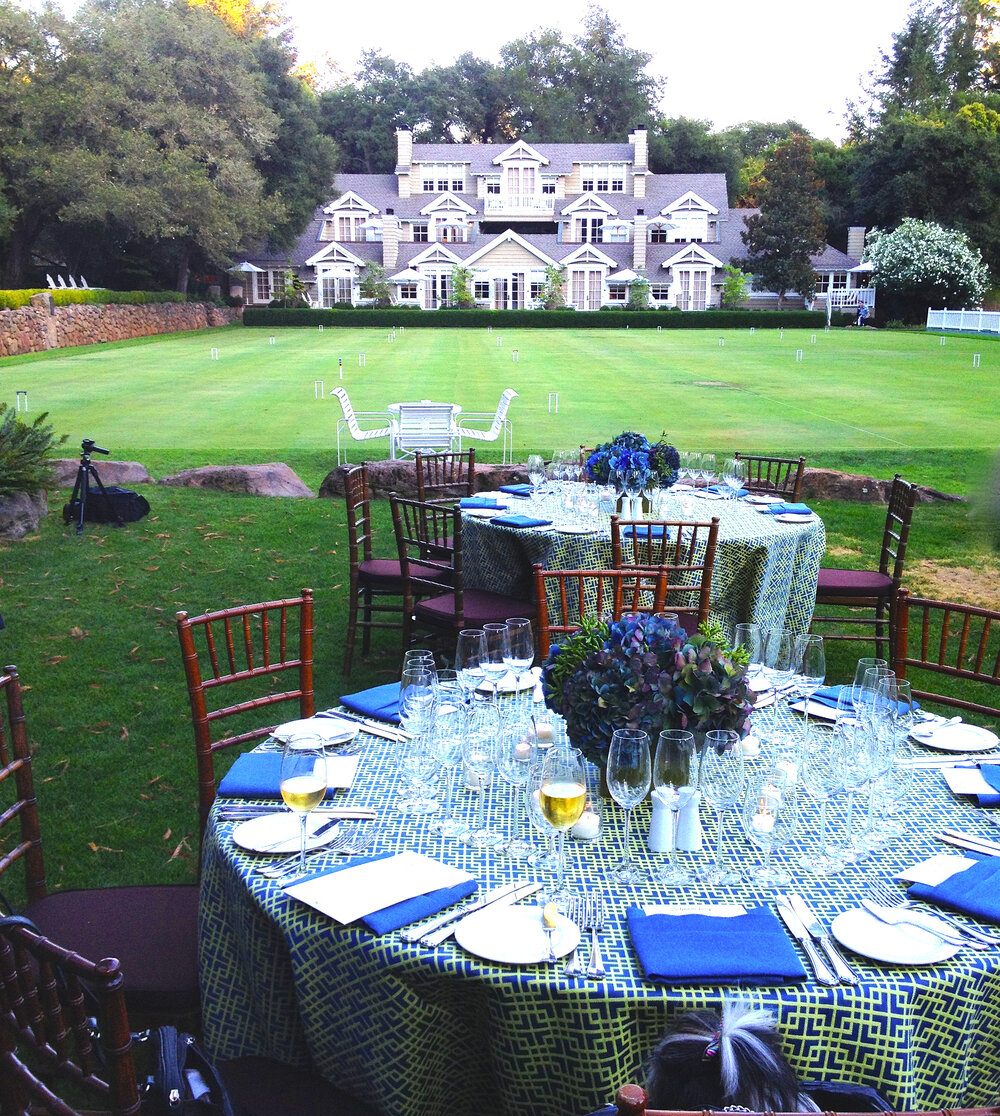
Following our first full day of Camp Schramsberg (read all about that here), Campers had the option to attend a Schramsberg Library Wine Dinner held at Meadowood Napa Valley Resort, one of the most exclusive resorts in the Napa Valley.
The Restaurant at Meadowood has received three Michelin stars in 2011, 2012 and 2013 and Executive Chef Christopher Kostow has received much critical acclaim for his commitment to local, sustainable California cuisine. In 2013 Chef Kostow received the James Beach Award for "Best Chef: West." Needless to say, I wasn't about to pass up this opportunity to experience amazing cuisine paired with Schramsberg library wine offerings!
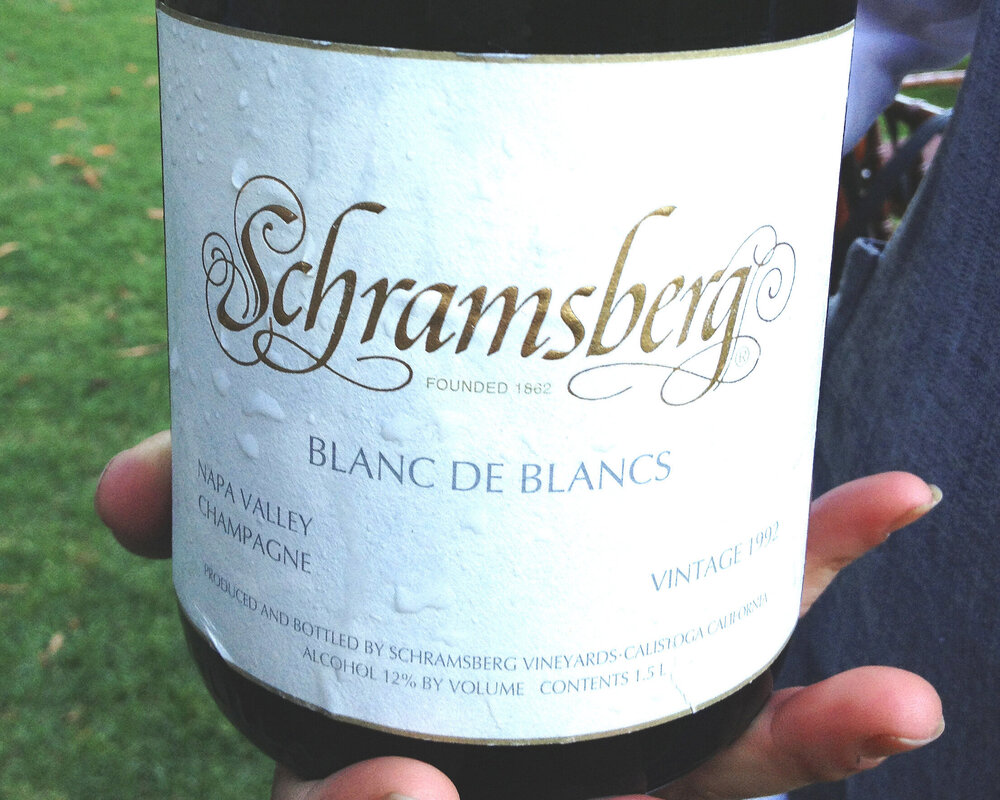
The Schramsberg Library Wine Dinner took place on Meadowood's verdant green croquet lawn and as we approached it looked like a foodie oasis beckoning to us on this balmy, wine country evening. The circular tables were draped in festive royal blue and green, geometrically patterned tablecloths and the main building of the resort loomed elegantly in the background.
We were greeted with flutes of 1992 Schramsberg Blanc de Blancs poured from magnum. Yep, we were definitely in the right place! Blanc de blancs literally means "white from whites" and is made from 100% Chardonnay grapes. This was the first wine Schramsberg made back in 1965 and was America's first commercially produced Chardonnay-based brut sparkling wine. In order to achieve added complexity, small lots of malolactic- and barrel-fermented wines are used in the blend with delicious results. Schramsberg's Blanc de Blancs gained international recognition in 1972 when President Nixon served the wine at the historic "Toast to Peace" in Beijing China. The '92 Blanc de Blancs tasted fresh and vibrant giving the impression of a much younger wine.
In fact, I had to try a few more glasses just to be sure! Dinner guests mixed and mingled over delicious passed hors d'oeuvres including Cucumber with Jumbo Lump Crab and Borage Flower that were a feast as much for the eyes as the palate. After some reminiscing about our busy day we gratefully took our seats and prepared for the deliciousness to come.
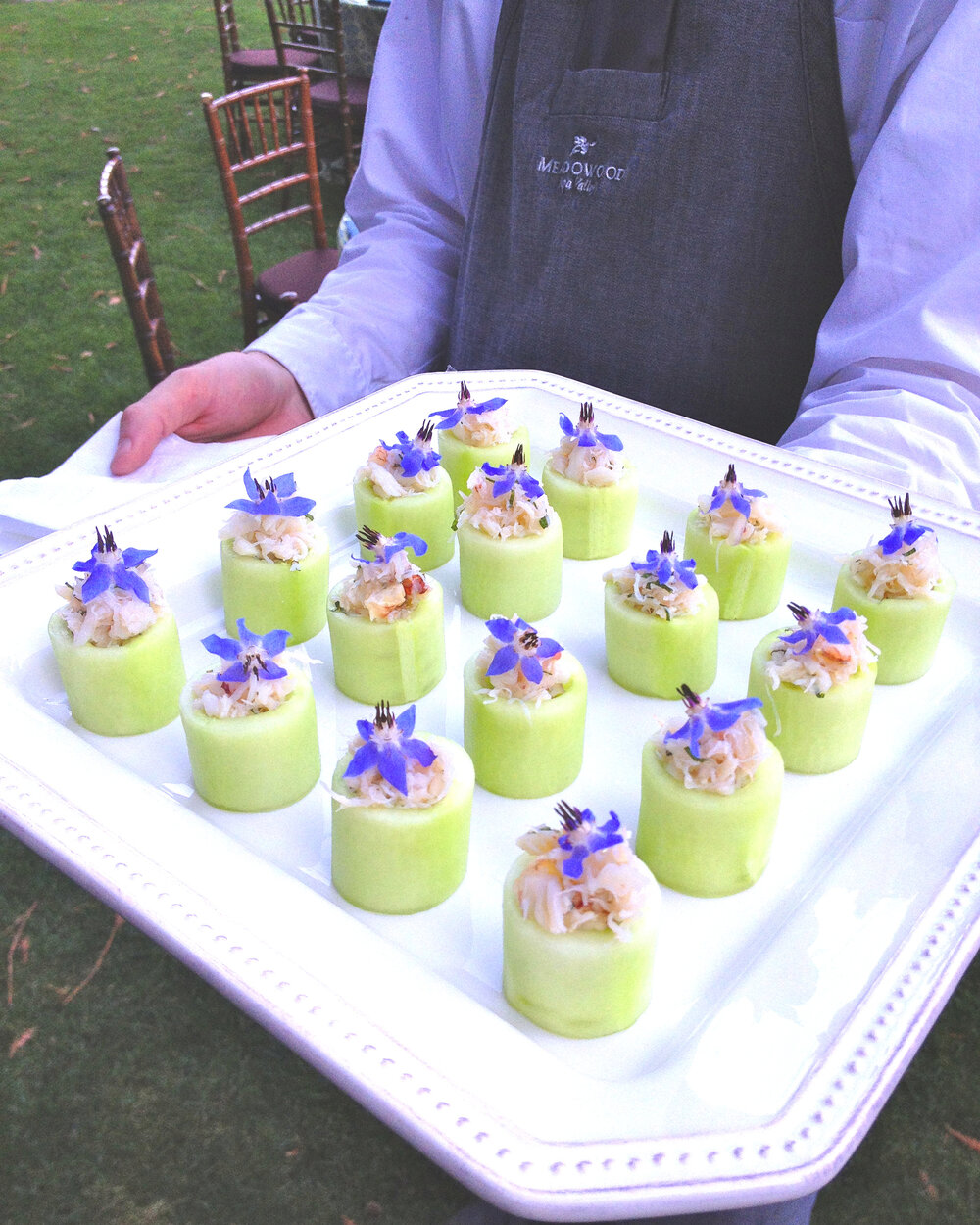
Cucumber with Crab & Borage Flowers
The first course was a beautiful Northern Pacific Halibut Wrapped in Prosciutto with Pickled Heirloom Melon, and Honeydew Consommé. The consommé was poured tableside which gave the dish extra panache. Overall, the halibut was light, flaky and succulent and the prosciutto added a delightfully salty bite and depth of flavor. Our pairing for the halibut was the 1997 J. Schram Late Disgorged, a blend of 70% Chardonnay and 30% Pinot Noir, which had a rich, toasty character with notes of citrus, baked apple and marzipan.
This special, limited edition wine was created in honor of the winery's 150th Anniversary as a tribute to Jacob and Annie Schram who founded Schramsberg, the second bonded winery in the Napa Valley. This wine spent almost fifteen years en tirage before being disgorged which resulted in lovely layers of richness, depth and complexity.
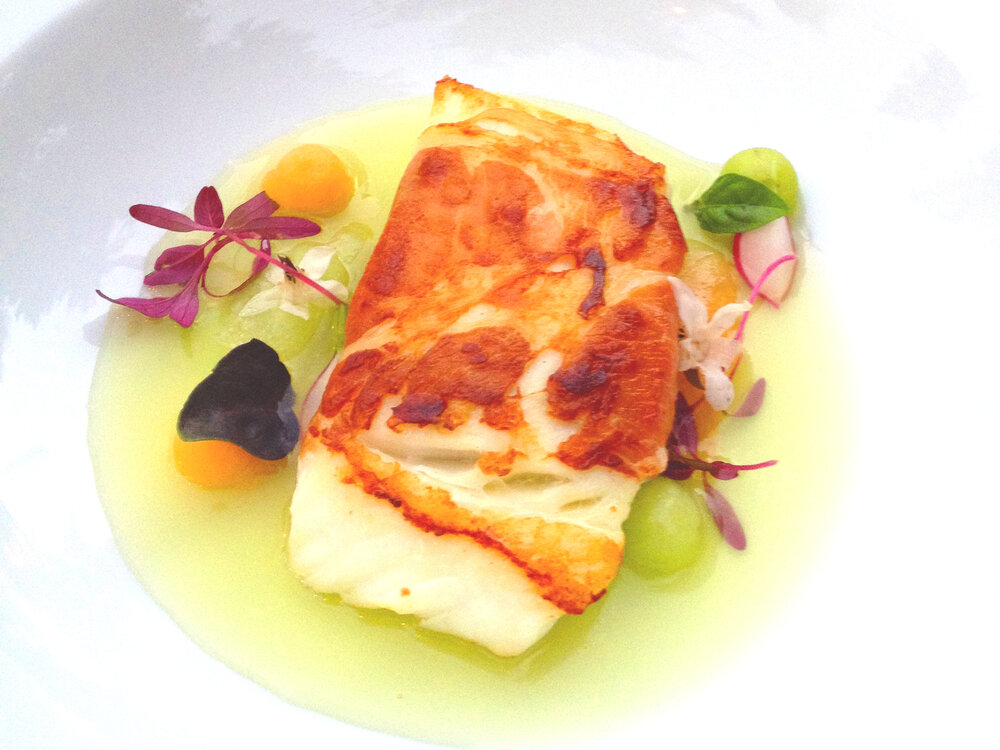
Pacific Northwest Halibut Wrapped in Prosciutto with Honeydew Consomme
Next was Roasted Duck with Smoked Potato Mousseline, Meadowood Garden Vegetables and Peach Gastrique. My table mates and I collectively agreed this was one of the most delicious duck dishes we'd ever tasted. It was lean and flavorful yet not at all fatty. With all the delicious flavor I was wondering what sparkling wine would not only stand up to, but also complement this dish.
The answer, my wine loving friends, was the 1994 Schramsberg Reserve. Made from predominantly Pinot Noir with some barrel fermented lots included in the blend, this multi-layered, full-bodied sparkler was the perfect choice. This wine's complexity manifested in harmonious notes of baked apple, pear, cherry and vanilla with an underpinning of baked pastry dough. With almost twenty years of age, this wine also tasted remarkably lively and fresh, beautifully demonstrating along with the previous wines of the meal the capability of sparkling wines to age with grace. As far as the pairing, the flavors of the wine and the duck worked beautifully together creating a fabulous synergy. This was definitely one of the most memorable pairings of the weekend.
In lieu of dessert, we were treated to a cheese course featuring Mt. Tam Cheese with Pine Nut Crostini, Quince and Stone Fruit Compote with our final wine of the evening. Mt. Tam triple cream cheese hails from the well known Cowgirl Creamery and is named for a Northern California landmark, Mt. Tamalpais. It is made from fresh, organic milk from Strauss Family Dairy and has a decadent, creamy texture.
The wine pairing for the cheese course was the 1999 Schramsberg Crémant Demi-Sec. The delicious richness and complexity this off-dry sparkler had developed after almost fifteen years made it a dessert in and of itself. Notes of pineapple, citrus and honey accompanied alluring spice notes as well as a fresh and balanced acidity.
This unique bottling is a dessert wine crafted from a unique blend of grapes including Flora (a cross between Sémillon and Gewürztraminer developed at U.C. Davis), Gewürztraminer, Pinot Noir, and Chardonnay. This wine was California's first “crémant” when it debuted in 1972 and the word crémant, which is French for "creamy," perfectly describes this delightful wine that has less pressure and a softer effervescence and mouthfeel than other cuvées. This wine also has some historic significance as it was served at President Reagan's Second Inaugural Luncheon, President Clinton's dinner for the Prime Minister of Canada and, most recently, at the sixtieth wedding anniversary of President and Mrs. George H.W. Bush.
Needless to say after a day of such decadence, we were all ready for bed and looking forward to Day Two of Camp Schramsberg and the adventures it would bring!
Earlier this month I had the pleasure of participating in Camp Schramsberg, a two day, education filled experience encompassing all aspects of sparkling wine production at Schramsberg Vineyards, aka "America's House of Sparkling Wine." This very special "camp" is offered twice a year, in the Spring and again in the Fall, to both consumers as well as individuals in the trade, and offers all attendees the opportunity to participate in and observe the seasonal happenings at the winery. September marks the beginning of harvest, an exciting time to be in California wine country. Before we embarked our two day adventure, campers were welcomed with dinner among the vineyards at Schramsberg in Calistoga, about 25 miles north of Napa.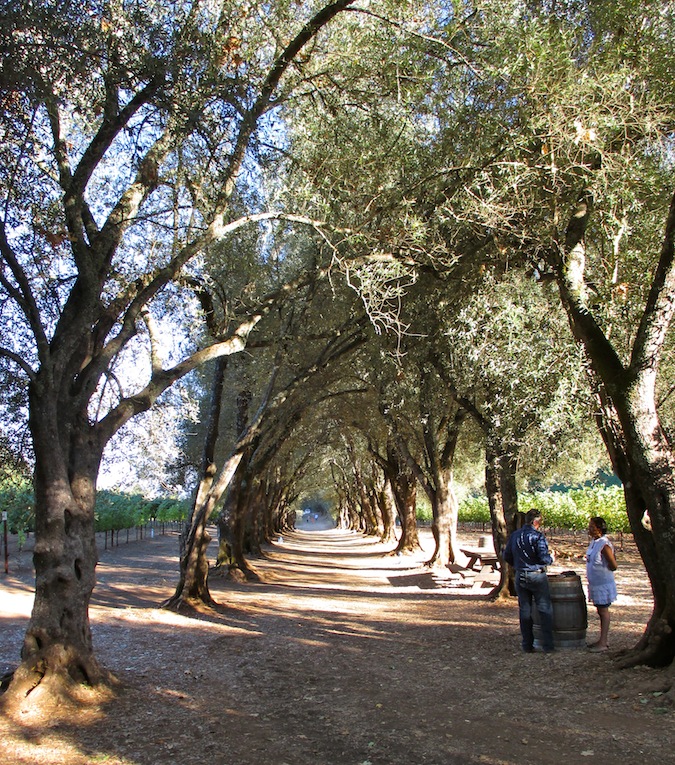 We arrived at the winery at sunset and followed an inviting path under a canopy of olive trees to a clearing where we were greeted by Hugh Davies, President and CEO of Schramsberg Vineyards. The welcome dinner took place in the J. Davies vineyard, named in honor of Hugh's father, Jack Davies, patriarch of the family who, with his wife Jamie, put Schramsberg Vineyards on the map as a world class sparkling wine house and ran it for over thirty years. The J. Davies vineyard is planted entirely to Cabernet Sauvignon from which the eponymous wine is made. We also had the pleasure of meeting Hugh's wife Monique (the two were married in this vineyard) as well as their three children who climbed trees and explored the vineyard while we sipped bubbly and got to know one another.We were welcomed with chilled flutes of Schramsberg's two single vineyard sparklers, the '08 Hyde Vineyards Napa Valley Carneros Brut and the '08 Jones Vineyard Napa Valley Carneros Brut. These delightful wines were perfect for quenching my thirst following a cross country flight and two hour drive up to wine country from San Francisco. They also paired beautifully with a variety of delicious hors d'oeuvres including Beef Tartare, Wild Salmon Crostini and, my personal favorite, Duck Confit "Chicken" Wings which provided a nice contrast to the crisp, sparkling wines. During the dinner we also had the chance to meet other key players at Schramsberg including Sparkling winemaker Keith Hock; Still Winemaker, Sean Thompson and Chef and Instructor for the weekend, the delightful Holly Peterson.
We arrived at the winery at sunset and followed an inviting path under a canopy of olive trees to a clearing where we were greeted by Hugh Davies, President and CEO of Schramsberg Vineyards. The welcome dinner took place in the J. Davies vineyard, named in honor of Hugh's father, Jack Davies, patriarch of the family who, with his wife Jamie, put Schramsberg Vineyards on the map as a world class sparkling wine house and ran it for over thirty years. The J. Davies vineyard is planted entirely to Cabernet Sauvignon from which the eponymous wine is made. We also had the pleasure of meeting Hugh's wife Monique (the two were married in this vineyard) as well as their three children who climbed trees and explored the vineyard while we sipped bubbly and got to know one another.We were welcomed with chilled flutes of Schramsberg's two single vineyard sparklers, the '08 Hyde Vineyards Napa Valley Carneros Brut and the '08 Jones Vineyard Napa Valley Carneros Brut. These delightful wines were perfect for quenching my thirst following a cross country flight and two hour drive up to wine country from San Francisco. They also paired beautifully with a variety of delicious hors d'oeuvres including Beef Tartare, Wild Salmon Crostini and, my personal favorite, Duck Confit "Chicken" Wings which provided a nice contrast to the crisp, sparkling wines. During the dinner we also had the chance to meet other key players at Schramsberg including Sparkling winemaker Keith Hock; Still Winemaker, Sean Thompson and Chef and Instructor for the weekend, the delightful Holly Peterson.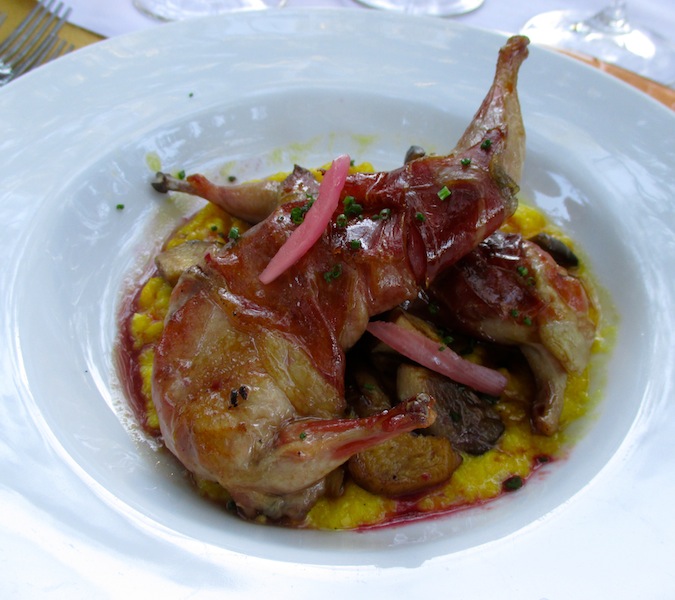 Once we were seated for dinner, the wine focus shifted to Schramsberg's still red wines, relatively new additions to the portfolio of this predominantly sparkling wine house. What better way to introduce them than to pair them with a delicious menu? The first course consisted of a beautiful La Quercia Speck Wrapped Quail with Creamed Corn, Trumpet Mushrooms and Pinot Noir Verjus paired with a duo of 2010 Davies single vineyard Pinot Noirs from the Londer Vineyard in Anderson Valley and the Nobles Vineyard from Sonoma Coast.The 2010 vintage represents the second vintage of the winery's still wines made from Pinot Noir. Both wines were lovely yet different: the Londer Vineyard Pinot was characterized by notes of ripe red and black fruit, licorice and spice while the Nobles Pinot exhibited notes of dried fruit and earth as well as firm tannins. Both wines paired nicely with the quail though I was partial to the Londer Vineyard Pinot with its plusher fruit and mild tannins.The main course of our vineyard dinner was a carnivore's dream featuring two different styles of succulent ribs: Slow Smoked Long Meadow Ranch Beef Ribs and Slow Smoked St. Louis Ribs with Memphis-style Barbeque Sauce, which ignited a rib rivalry among the Campers! I have to admit both types of ribs were mouth-wateringly delicious and paired well with the fruity and approachable 2009 J. Davies Cabernet Sauvignon from the Diamond Mountain District. My tablemates even made an agreement early on in the meal that it was perfectly acceptable to use our hands in lieu of utensils so we were all in virtual Hog Heaven - pun intended!
Once we were seated for dinner, the wine focus shifted to Schramsberg's still red wines, relatively new additions to the portfolio of this predominantly sparkling wine house. What better way to introduce them than to pair them with a delicious menu? The first course consisted of a beautiful La Quercia Speck Wrapped Quail with Creamed Corn, Trumpet Mushrooms and Pinot Noir Verjus paired with a duo of 2010 Davies single vineyard Pinot Noirs from the Londer Vineyard in Anderson Valley and the Nobles Vineyard from Sonoma Coast.The 2010 vintage represents the second vintage of the winery's still wines made from Pinot Noir. Both wines were lovely yet different: the Londer Vineyard Pinot was characterized by notes of ripe red and black fruit, licorice and spice while the Nobles Pinot exhibited notes of dried fruit and earth as well as firm tannins. Both wines paired nicely with the quail though I was partial to the Londer Vineyard Pinot with its plusher fruit and mild tannins.The main course of our vineyard dinner was a carnivore's dream featuring two different styles of succulent ribs: Slow Smoked Long Meadow Ranch Beef Ribs and Slow Smoked St. Louis Ribs with Memphis-style Barbeque Sauce, which ignited a rib rivalry among the Campers! I have to admit both types of ribs were mouth-wateringly delicious and paired well with the fruity and approachable 2009 J. Davies Cabernet Sauvignon from the Diamond Mountain District. My tablemates even made an agreement early on in the meal that it was perfectly acceptable to use our hands in lieu of utensils so we were all in virtual Hog Heaven - pun intended!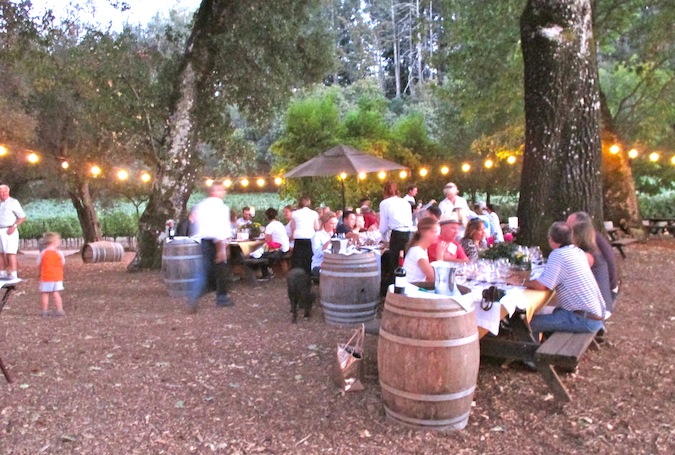 After our BBQ feast, we were treated to a cheese course featuring Fiscalini Cheddar, Point Reyes Toma and Shepherdista cheeses accompanied by black mission figs, apples and almonds. It was difficult not to consume all the delicious food and wine over the course of the evening, however, upon advice from Matt Levy, our fearless Camp Counselor, we were careful not to indulge too much in anticipation of the early morning ahead - buses were scheduled to leave Meadowood at 7:30am sharp. A good night's sleep was mandatory!
After our BBQ feast, we were treated to a cheese course featuring Fiscalini Cheddar, Point Reyes Toma and Shepherdista cheeses accompanied by black mission figs, apples and almonds. It was difficult not to consume all the delicious food and wine over the course of the evening, however, upon advice from Matt Levy, our fearless Camp Counselor, we were careful not to indulge too much in anticipation of the early morning ahead - buses were scheduled to leave Meadowood at 7:30am sharp. A good night's sleep was mandatory!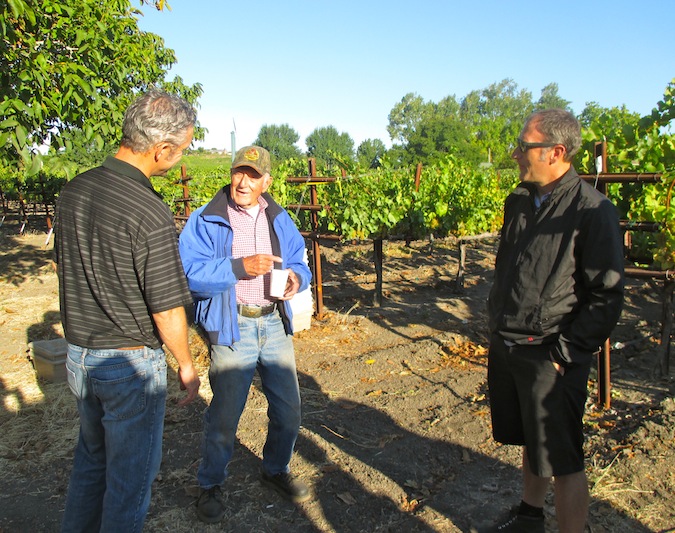 The next morning, we boarded the "Schramsberg Express" bus and headed towards Carneros. We were very fortunate to have Hugh Davies himself as our tour guide and enjoyed a 45-minute narrated drive to our destination getting the inside scoop on the beautiful landscape that unfolded before us. Highlights included the impact of the recent heat spike and its effect on various microclimates; who's Zinfandel vines were just being replanted; and the details of Jack and Jamie Davies' foray into the Cognac business with Remy Martin in the early days.Before we knew it we arrived at the Tognetti Vineyard where we were greeted by none other than Jack Tognetti himself, one of the spriest 90-something-year-olds I've ever met. He was joined by Schramsberg sparkling winemaker Keith Hock and Jaime, a Vineyard Manager who has been with Schramsberg since 1968!Jack Tognetti worked in the steamship business for twenty years but always thought of himself as a "farmer at heart." Tognetti purchased his vineyard and started planting Chardonnay grapes in 1980 and while he initially sold his grapes to the Swanson family, since 1998 he's been selling his Chardonnay exclusively to Schramsberg.He describes the climate as "cool and consistent: perfect for growing grapes for sparkling wine, " and about his working relationship with Schramsberg, "I try to give them nice fruit otherwise they bitch!" The vineyard produces approximately 80 tons of fruit consisting of a variety of clones including Monticello, the one we would be harvesting today. Beneath the vineyard soil is a pan of clay which is good at retaining water, making for very vigorous vines. The vines are grown on a quadrilateral trellis system and the grapes are picked between 17-21 Brix, the ideal range according to Keith Hock who gets a call from Tognetti at the appropriate time saying, "Keith, my damned vines are ready - pick 'em!"
The next morning, we boarded the "Schramsberg Express" bus and headed towards Carneros. We were very fortunate to have Hugh Davies himself as our tour guide and enjoyed a 45-minute narrated drive to our destination getting the inside scoop on the beautiful landscape that unfolded before us. Highlights included the impact of the recent heat spike and its effect on various microclimates; who's Zinfandel vines were just being replanted; and the details of Jack and Jamie Davies' foray into the Cognac business with Remy Martin in the early days.Before we knew it we arrived at the Tognetti Vineyard where we were greeted by none other than Jack Tognetti himself, one of the spriest 90-something-year-olds I've ever met. He was joined by Schramsberg sparkling winemaker Keith Hock and Jaime, a Vineyard Manager who has been with Schramsberg since 1968!Jack Tognetti worked in the steamship business for twenty years but always thought of himself as a "farmer at heart." Tognetti purchased his vineyard and started planting Chardonnay grapes in 1980 and while he initially sold his grapes to the Swanson family, since 1998 he's been selling his Chardonnay exclusively to Schramsberg.He describes the climate as "cool and consistent: perfect for growing grapes for sparkling wine, " and about his working relationship with Schramsberg, "I try to give them nice fruit otherwise they bitch!" The vineyard produces approximately 80 tons of fruit consisting of a variety of clones including Monticello, the one we would be harvesting today. Beneath the vineyard soil is a pan of clay which is good at retaining water, making for very vigorous vines. The vines are grown on a quadrilateral trellis system and the grapes are picked between 17-21 Brix, the ideal range according to Keith Hock who gets a call from Tognetti at the appropriate time saying, "Keith, my damned vines are ready - pick 'em!"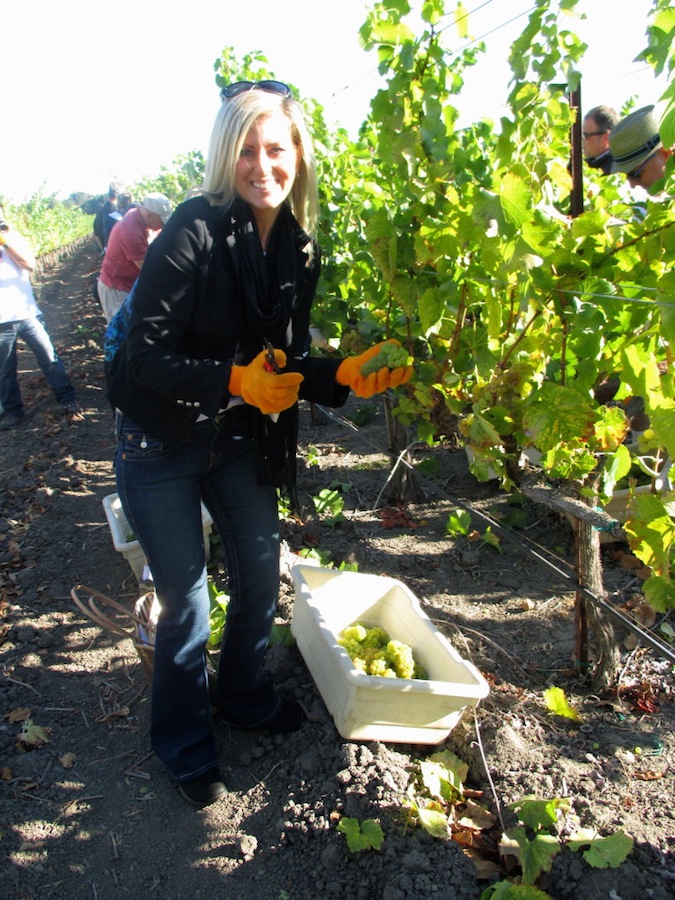 After our introduction to Jack and his vineyard we donned our gloves and grabbed our secateurs and headed down the vineyard rows, plastic bins in hand. Our challenge was to harvest as close to one ton of fruit as we could so everyone quickly got to work - no pressure!While initially unsure of exactly where to snip each cluster of grapes, with some instruction from Keith and Hugh I found my rhythm and was soon harvesting away. The clusters were large and heavy and the ripe Chardonnay grapes tasted like candy. Before I knew it, my bin was full and I just kept on harvesting until I had completed three whole bins. Everyone was really getting into the task at hand and before we knew it, all the grapes were harvested. The next step was to take the grapes we had freshly harvested back to the winery for pressing.
After our introduction to Jack and his vineyard we donned our gloves and grabbed our secateurs and headed down the vineyard rows, plastic bins in hand. Our challenge was to harvest as close to one ton of fruit as we could so everyone quickly got to work - no pressure!While initially unsure of exactly where to snip each cluster of grapes, with some instruction from Keith and Hugh I found my rhythm and was soon harvesting away. The clusters were large and heavy and the ripe Chardonnay grapes tasted like candy. Before I knew it, my bin was full and I just kept on harvesting until I had completed three whole bins. Everyone was really getting into the task at hand and before we knew it, all the grapes were harvested. The next step was to take the grapes we had freshly harvested back to the winery for pressing.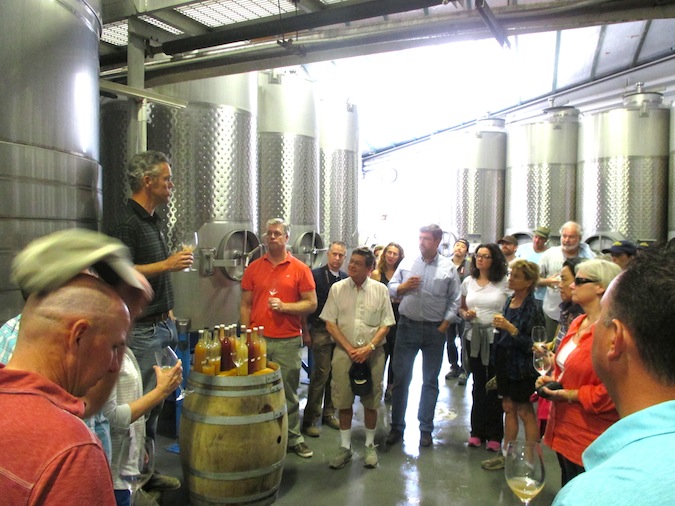 Back at Schramsberg, fueled by our success in the vineyard as well as the coffee and doughnut holes on the bus ride back, we were excited to taste the fruits of our labor. In addition to the freshly pressed juice from the Tognetti vineyard, which was sweet and grapey, we also tasted through a variety of wines in various states of fermentation.The samples in the bottles resembled murky, opaque lemonade, orange or cranberry juice and tasted like apples and citrus with yeasty overtones which we happily spat out onto the concrete floor. These wines were definitely not what you'd want to drink a whole glass of but a necessary step along the way to becoming a fabulous Schramsberg sparkler.First we tasted samples from the tanks and then from barrel, the latter being more bitter and difficult to tolerate and while unpleasant tasting, it was very interesting to experience the various stages of the fermentation process and experience first-hand the evolution of sparkling wine. Following the vinous assault on our palates, we were bussed off to Meadowood for lunch - the timing couldn't have been more perfect!
Back at Schramsberg, fueled by our success in the vineyard as well as the coffee and doughnut holes on the bus ride back, we were excited to taste the fruits of our labor. In addition to the freshly pressed juice from the Tognetti vineyard, which was sweet and grapey, we also tasted through a variety of wines in various states of fermentation.The samples in the bottles resembled murky, opaque lemonade, orange or cranberry juice and tasted like apples and citrus with yeasty overtones which we happily spat out onto the concrete floor. These wines were definitely not what you'd want to drink a whole glass of but a necessary step along the way to becoming a fabulous Schramsberg sparkler.First we tasted samples from the tanks and then from barrel, the latter being more bitter and difficult to tolerate and while unpleasant tasting, it was very interesting to experience the various stages of the fermentation process and experience first-hand the evolution of sparkling wine. Following the vinous assault on our palates, we were bussed off to Meadowood for lunch - the timing couldn't have been more perfect!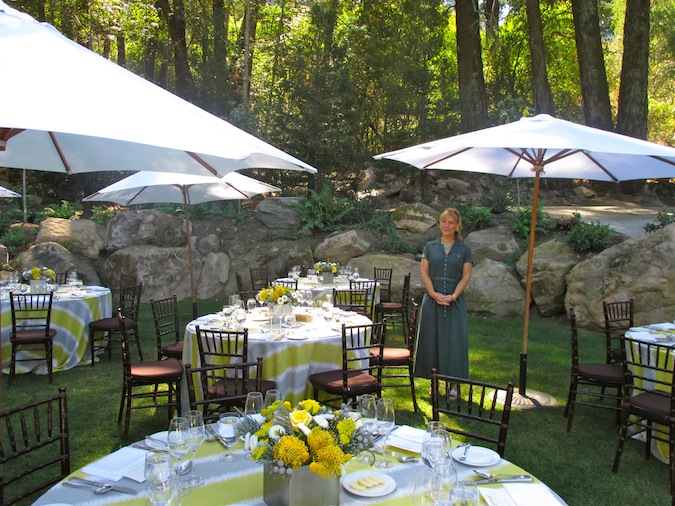 Waiting for us on the lawn at Meadowood was our Instructor for the rest of the afternoon, the delightful Holly Peterson, a renowned Chef who helped the Davies family conceive of and develop the Camp Schramsberg program 18 years ago.Peterson has quite an impressive resume including a degree in enology from the University of California, Davis and the Grand Diplome de Cuisine from the famed La Varenne Cooking School in France. She has shared her talent and passion for pairing food and wine in restaurants and venues around the world yet she and her family are very much a part of California wine history and community.Her father Richard Peterson is a California wine country pioneer and sister Heidi Peterson Barrett is a winemaker known for producing such well known California cult collectibles as Screaming Eagle, Dalla Valle and Paradigm to name a few.
Waiting for us on the lawn at Meadowood was our Instructor for the rest of the afternoon, the delightful Holly Peterson, a renowned Chef who helped the Davies family conceive of and develop the Camp Schramsberg program 18 years ago.Peterson has quite an impressive resume including a degree in enology from the University of California, Davis and the Grand Diplome de Cuisine from the famed La Varenne Cooking School in France. She has shared her talent and passion for pairing food and wine in restaurants and venues around the world yet she and her family are very much a part of California wine history and community.Her father Richard Peterson is a California wine country pioneer and sister Heidi Peterson Barrett is a winemaker known for producing such well known California cult collectibles as Screaming Eagle, Dalla Valle and Paradigm to name a few.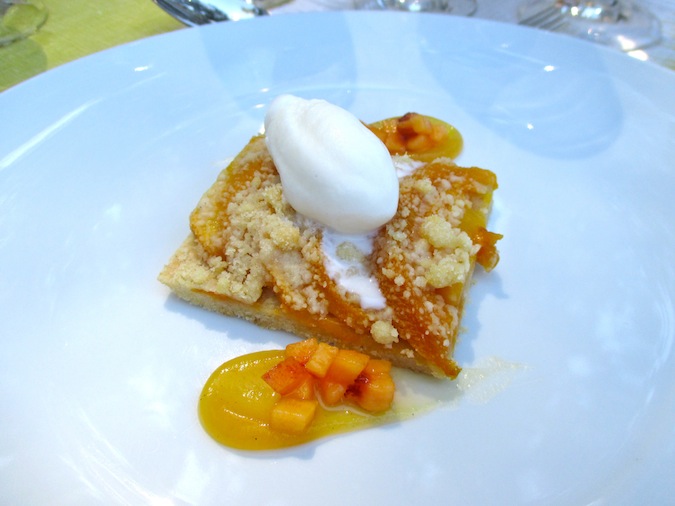 We sat down to a lovely three course lunch paired with Schramsberg's sparkling wines featuring Squash Consomme with Fresh Burrata, White Anchovies, Garden Herbs and Basil Blossoms paired with the 2005 J. Schram Rosé which continued to flow into the second course of Grilled Halibut with Roasted Baby Beets, Horseradish Creme Fraiche and Tempura Avocado. The rosé paired remarkably well with the various flavors and textures of the halibut dish especially the tempura avocado, the wine's natural acidity cutting through the rich, creamy texture. Our delightful lunch ended with one of my favorite pairings of the weekend: a Peach Cobbler with Anise Ice Cream paired with the 2008 Schramsberg Cremant Demi-Sec. The anise ice cream synergized with notes in the wine creating that elusive and oh so special 1+1=3 effect! Needless to say there's wasn't a crumb left on my plate.After our decadent, delicious lunch, we gathered around Peterson on the lawn as she taught us the art of sabrage, a technique for opening a bottle of Champagne using a sabre, a practice initially made famous by Napoleon who usually did so following a victory on the battlefield while on horseback. "The bottle consists of three components," Peterson instructed, "the two halves of the bottle and the collar, which sits on top of the neck of the bottle and holds the cork."She demonstrated the technique by holding a bottle of bubbly in one hand at a 45 degree angle with the seam facing up. Holding the sabre in the other hand, she ran the blade, tentatively at first, along the seam of the bottle then using enough force to hit the collar and cause the seam to "pop," shooting the collar off of the bottle in grand fashion with the cork still in it. Sounds easy enough, right? Actually it's not nearly as hard as it sounds or looks, you just need to "pop the seam," a phrase which would become our mantra as, one by one, each camper tried their hand at this age old tradition.
We sat down to a lovely three course lunch paired with Schramsberg's sparkling wines featuring Squash Consomme with Fresh Burrata, White Anchovies, Garden Herbs and Basil Blossoms paired with the 2005 J. Schram Rosé which continued to flow into the second course of Grilled Halibut with Roasted Baby Beets, Horseradish Creme Fraiche and Tempura Avocado. The rosé paired remarkably well with the various flavors and textures of the halibut dish especially the tempura avocado, the wine's natural acidity cutting through the rich, creamy texture. Our delightful lunch ended with one of my favorite pairings of the weekend: a Peach Cobbler with Anise Ice Cream paired with the 2008 Schramsberg Cremant Demi-Sec. The anise ice cream synergized with notes in the wine creating that elusive and oh so special 1+1=3 effect! Needless to say there's wasn't a crumb left on my plate.After our decadent, delicious lunch, we gathered around Peterson on the lawn as she taught us the art of sabrage, a technique for opening a bottle of Champagne using a sabre, a practice initially made famous by Napoleon who usually did so following a victory on the battlefield while on horseback. "The bottle consists of three components," Peterson instructed, "the two halves of the bottle and the collar, which sits on top of the neck of the bottle and holds the cork."She demonstrated the technique by holding a bottle of bubbly in one hand at a 45 degree angle with the seam facing up. Holding the sabre in the other hand, she ran the blade, tentatively at first, along the seam of the bottle then using enough force to hit the collar and cause the seam to "pop," shooting the collar off of the bottle in grand fashion with the cork still in it. Sounds easy enough, right? Actually it's not nearly as hard as it sounds or looks, you just need to "pop the seam," a phrase which would become our mantra as, one by one, each camper tried their hand at this age old tradition.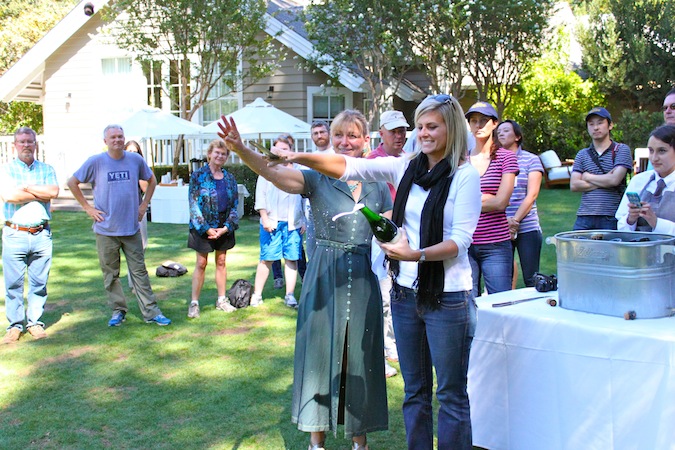 Peterson offered us two weapons of choice to practice our sabering skills, a Laguiole Champagne sabre as well as a genuine antique sabre she procured from a French vintage shop that looked as if it may have belonged to Napoleon himself! As a practitioner of sabrage with my own Laguiole sabre at home, I looked forward to using the vintage saber when it came time to decapitate my bottle.It was quite heavy and much larger than the sabre I was used to using and as I grasped it I had a fleeting feeling of being on the battlefield then realized I'd much rather be on the lawn at Meadowood about to open a bottle of sparkling wine. The larger sabre made the process much easier due to its weight and momentum and before I knew it, the cork was shooting across the lawn and I was victorious!
Peterson offered us two weapons of choice to practice our sabering skills, a Laguiole Champagne sabre as well as a genuine antique sabre she procured from a French vintage shop that looked as if it may have belonged to Napoleon himself! As a practitioner of sabrage with my own Laguiole sabre at home, I looked forward to using the vintage saber when it came time to decapitate my bottle.It was quite heavy and much larger than the sabre I was used to using and as I grasped it I had a fleeting feeling of being on the battlefield then realized I'd much rather be on the lawn at Meadowood about to open a bottle of sparkling wine. The larger sabre made the process much easier due to its weight and momentum and before I knew it, the cork was shooting across the lawn and I was victorious!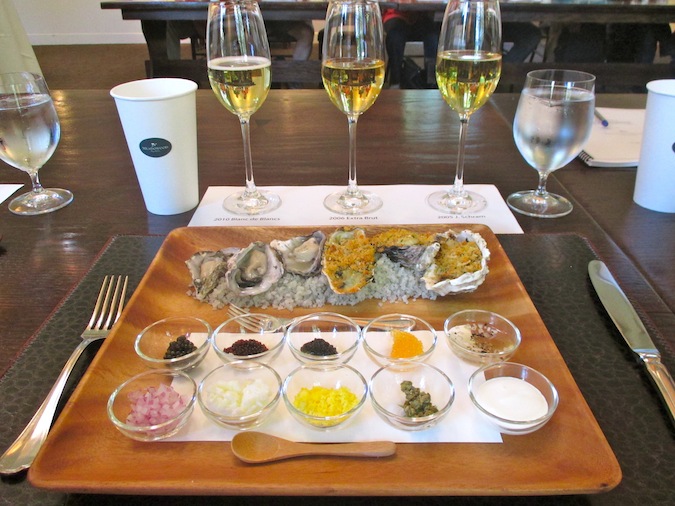 We finished the day with a lesson on pairing sparkling wine with food, focusing on "The Classics." On the tasting mats before us were three glasses of Schramsberg bubbly: the 2010 Blanc de Blancs, 2006 Extra Brut and the 2005 J. Schram. Peterson guided us through a tasting of the sparkling wines and we acquainted ourselves with the nuances of each one before any food was introduced. After this arduous task we were presented with a platter of delightful selections from the sea to pair with the sparklers including raw oysters, Oysters Rockefeller and a selection of caviar and associated accoutrements.Over the remainder of the day we experimented with various pairing combinations, challenging some conventionally held beliefs and discovering some new favorites. The raw oysters (Miyagi oysters from the Pacific Northwest) with mignonette were brilliant paired with the 2010 Blanc de Blancs as one might expect. The Oyster Rockefeller on the other hand paired best with the 2005 J. Schram, the Schramsberg tête de cuvée, with its rich, nutty profile. The caviar pairings also revealed some surprises such as the significant difference the toppings make. Truffled Tiger-Eye Whitefish Roe topped with egg yolk was utterly delicious when paired with the 2006 Extra Brut; however, when the yolk was swapped for egg white the result was nowhere near as pleasing. By the end of the seminar we had experimented with a variety of options and learned a lot about the nuances of creating the "perfect pairing."As our first day of Camp drew to a close, we were blissfully weary from all the harvesting, sabrage and sparkling wine and food pairing (can you hear the violins?). The day was not entirely done, however, because just a few short hours after our last class was over the Schramsberg Library Wine Dinner would begin and you know there's no way I was going to miss that! Stay tuned for "Part Two" of my Camp Schramsberg adventures.Cheers,
We finished the day with a lesson on pairing sparkling wine with food, focusing on "The Classics." On the tasting mats before us were three glasses of Schramsberg bubbly: the 2010 Blanc de Blancs, 2006 Extra Brut and the 2005 J. Schram. Peterson guided us through a tasting of the sparkling wines and we acquainted ourselves with the nuances of each one before any food was introduced. After this arduous task we were presented with a platter of delightful selections from the sea to pair with the sparklers including raw oysters, Oysters Rockefeller and a selection of caviar and associated accoutrements.Over the remainder of the day we experimented with various pairing combinations, challenging some conventionally held beliefs and discovering some new favorites. The raw oysters (Miyagi oysters from the Pacific Northwest) with mignonette were brilliant paired with the 2010 Blanc de Blancs as one might expect. The Oyster Rockefeller on the other hand paired best with the 2005 J. Schram, the Schramsberg tête de cuvée, with its rich, nutty profile. The caviar pairings also revealed some surprises such as the significant difference the toppings make. Truffled Tiger-Eye Whitefish Roe topped with egg yolk was utterly delicious when paired with the 2006 Extra Brut; however, when the yolk was swapped for egg white the result was nowhere near as pleasing. By the end of the seminar we had experimented with a variety of options and learned a lot about the nuances of creating the "perfect pairing."As our first day of Camp drew to a close, we were blissfully weary from all the harvesting, sabrage and sparkling wine and food pairing (can you hear the violins?). The day was not entirely done, however, because just a few short hours after our last class was over the Schramsberg Library Wine Dinner would begin and you know there's no way I was going to miss that! Stay tuned for "Part Two" of my Camp Schramsberg adventures.Cheers,

Earlier this month I had the pleasure of participating in Camp Schramsberg, a two day, education filled experience encompassing all aspects of sparkling wine production at Schramsberg Vineyards, aka “America’s House of Sparkling Wine.” This very special “camp” is offered twice a year, in the Spring and again in the Fall, to both consumers as well as individuals in the trade, and offers all attendees the opportunity to participate in and observe the seasonal happenings at the winery. September marks the beginning of harvest, an exciting time to be in California wine country. Before we embarked our two day adventure, campers were welcomed with dinner among the vineyards at Schramsberg in Calistoga, about 25 miles north of Napa.

We arrived at the winery at sunset and followed an inviting path under a canopy of olive trees to a clearing where we were greeted by Hugh Davies, President and CEO of Schramsberg Vineyards. The welcome dinner took place in the J. Davies vineyard, named in honor of Hugh’s father, Jack Davies, patriarch of the family who, with his wife Jamie, put Schramsberg Vineyards on the map as a world class sparkling wine house and ran it for over thirty years. The J. Davies vineyard is planted entirely to Cabernet Sauvignon from which the eponymous wine is made. We also had the pleasure of meeting Hugh’s wife Monique (the two were married in this vineyard) as well as their three children who climbed trees and explored the vineyard while we sipped bubbly and got to know one another.
We were welcomed with chilled flutes of Schramsberg’s two single vineyard sparklers, the ’08 Hyde Vineyards Napa Valley Carneros Brut and the ’08 Jones Vineyard Napa Valley Carneros Brut. These delightful wines were perfect for quenching my thirst following a cross country flight and two hour drive up to wine country from San Francisco. They also paired beautifully with a variety of delicious hors d’oeuvres including Beef Tartare, Wild Salmon Crostini and, my personal favorite, Duck Confit “Chicken” Wings which provided a nice contrast to the crisp, sparkling wines. During the dinner we also had the chance to meet other key players at Schramsberg including Sparkling winemaker Keith Hock; Still Winemaker, Sean Thompson and Chef and Instructor for the weekend, the delightful Holly Peterson.

Once we were seated for dinner, the wine focus shifted to Schramsberg’s still red wines, relatively new additions to the portfolio of this predominantly sparkling wine house. What better way to introduce them than to pair them with a delicious menu? The first course consisted of a beautiful La Quercia Speck Wrapped Quail with Creamed Corn, Trumpet Mushrooms and Pinot Noir Verjus paired with a duo of 2010 Davies single vineyard Pinot Noirs from the Londer Vineyard in Anderson Valley and the Nobles Vineyard from Sonoma Coast. The 2010 vintage represents the second vintage of the winery’s still wines made from Pinot Noir. Both wines were lovely yet different: the Londer Vineyard Pinot was characterized by notes of ripe red and black fruit, licorice and spice while the Nobles Pinot exhibited notes of dried fruit and earth as well as firm tannins. Both wines paired nicely with the quail though I was partial to the Londer Vineyard Pinot with its plusher fruit and mild tannins.
The main course of our vineyard dinner was a carnivore’s dream featuring two different styles of succulent ribs: Slow Smoked Long Meadow Ranch Beef Ribs and Slow Smoked St. Louis Ribs with Memphis-style Barbeque Sauce, which ignited a rib rivalry among the Campers! I have to admit both types of ribs were mouth-wateringly delicious and paired well with the fruity and approachable 2009 J. Davies Cabernet Sauvignon from the Diamond Mountain District. My tablemates even made an agreement early on in the meal that it was perfectly acceptable to use our hands in lieu of utensils so we were all in virtual Hog Heaven – pun intended!

After our BBQ feast, we were treated to a cheese course featuring Fiscalini Cheddar, Point Reyes Toma and Shepherdista cheeses accompanied by black mission figs, apples and almonds. It was difficult not to consume all the delicious food and wine over the course of the evening, however, upon advice from Matt Levy, our fearless Camp Counselor, we were careful not to indulge too much in anticipation of the early morning ahead – buses were scheduled to leave Meadowood at 7:30am sharp. A good night’s sleep was mandatory!

The next morning, we boarded the “Schramsberg Express” bus and headed towards Carneros. We were very fortunate to have Hugh Davies himself as our tour guide and enjoyed a 45-minute narrated drive to our destination getting the inside scoop on the beautiful landscape that unfolded before us. Highlights included the impact of the recent heat spike and its effect on various microclimates; who’s Zinfandel vines were just being replanted; and the details of Jack and Jamie Davies’ foray into the Cognac business with Remy Martin in the early days. Before we knew it we arrived at the Tognetti Vineyard where we were greeted by none other than Jack Tognetti himself, one of the spriest 9o-something-year-olds I’ve ever met. He was joined by Schramsberg sparkling winemaker Keith Hock and Jaime, a Vineyard Manager who has been with Schramsberg since 1968!
Jack Tognetti worked in the steamship business for twenty years but always thought of himself as a “farmer at heart.” Tognetti purchased his vineyard and started planting Chardonnay grapes in 1980 and while he initially sold his grapes to the Swanson family, since 1998 he’s been selling his Chardonnay exclusively to Schramsberg. He describes the climate as “cool and consistent: perfect for growing grapes for sparkling wine, ” and about his working relationship with Schramsberg, “I try to give them nice fruit otherwise they bitch!” The vineyard produces approximately 80 tons of fruit consisting of a variety of clones including Monticello, the one we would be harvesting today. Beneath the vineyard soil is a pan of clay which is good at retaining water, making for very vigorous vines. The vines are grown on a quadrilateral trellis system and the grapes are picked between 17-21 Brix, the ideal range according to Keith Hock who gets a call from Tognetti at the appropriate time saying, “Keith, my damned vines are ready – pick ‘em!”

After our introduction to Jack and his vineyard we donned our gloves and grabbed our secateurs and headed down the vineyard rows, plastic bins in hand. Our challenge was to harvest as close to one ton of fruit as we could so everyone quickly got to work – no pressure! While initially unsure of exactly where to snip each cluster of grapes, with some instruction from Keith and Hugh I found my rhythm and was soon harvesting away. The clusters were large and heavy and the ripe Chardonnay grapes tasted like candy. Before I knew it, my bin was full and I just kept on harvesting until I had completed three whole bins. Everyone was really getting into the task at hand and before we knew it, all the grapes were harvested. The next step was to take the grapes we had freshly harvested back to the winery for pressing.

Back at Schramsberg, fueled by our success in the vineyard as well as the coffee and doughnut holes on the bus ride back, we were excited to taste the fruits of our labor. In addition to the freshly pressed juice from the Tognetti vineyard, which was sweet and grapey, we also tasted through a variety of wines in various states of fermentation. The samples in the bottles resembled murky, opaque lemonade, orange or cranberry juice and tasted like apples and citrus with yeasty overtones which we happily spat out onto the concrete floor. These wines were definitely not what you’d want to drink a whole glass of but a necessary step along the way to becoming a fabulous Schramsberg sparkler. First we tasted samples from the tanks and then from barrel, the latter being more bitter and difficult to tolerate and while unpleasant tasting, it was very interesting to experience the various stages of the fermentation process and experience first-hand the evolution of sparkling wine. Following the vinous assault on our palates, we were bussed off to Meadowood for lunch – the timing couldn’t have been more perfect!

Waiting for us on the lawn at Meadowood was our Instructor for the rest of the afternoon, the delightful Holly Peterson, a renowned Chef who helped the Davies family conceive of and develop the Camp Schramsberg program 18 years ago. Peterson has quite an impressive resume including a degree in enology from the University of California, Davis and the Grand Diplome de Cuisine from the famed La Varenne Cooking School in France. She has shared her talent and passion for pairing food and wine in restaurants and venues around the world yet she and her family are very much a part of California wine history and community. Her father Richard Peterson is a California wine country pioneer and sister Heidi Peterson Barrett is a winemaker known for producing such well known California cult collectibles as Screaming Eagle, Dalla Valle and Paradigm to name a few.

We sat down to a lovely three course lunch paired with Schramsberg’s sparkling wines featuring Squash Consomme with Fresh Burrata, White Anchovies, Garden Herbs and Basil Blossoms paired with the 2005 J. Schram Rosé which continued to flow into the second course of Grilled Halibut with Roasted Baby Beets, Horseradish Creme Fraiche and Tempura Avocado. The rosé paired remarkably well with the various flavors and textures of the halibut dish especially the tempura avocado, the wine’s natural acidity cutting through the rich, creamy texture. Our delightful lunch ended with one of my favorite pairings of the weekend: a Peach Cobbler with Anise Ice Cream paired with the 2008 Schramsberg Cremant Demi-Sec. The anise ice cream synergized with notes in the wine creating that elusive and oh so special 1+1=3 effect! Needless to say there’s wasn’t a crumb left on my plate.
After our decadent, delicious lunch, we gathered around Peterson on the lawn as she taught us the art of sabrage, a technique for opening a bottle of Champagne using a sabre, a practice initially made famous by Napoleon who usually did so following a victory on the battlefield while on horseback. “The bottle consists of three components,” Peterson instructed, “the two halves of the bottle and the collar, which sits on top of the neck of the bottle and holds the cork.” She demonstrated the technique by holding a bottle of bubbly in one hand at a 45 degree angle with the seam facing up. Holding the sabre in the other hand, she ran the blade, tentatively at first, along the seam of the bottle then using enough force to hit the collar and cause the seam to “pop,” shooting the collar off of the bottle in grand fashion with the cork still in it. Sounds easy enough, right? Actually it’s not nearly as hard as it sounds or looks, you just need to “pop the seam,” a phrase which would become our mantra as, one by one, each camper tried their hand at this age old tradition.

Peterson offered us two weapons of choice to practice our sabering skills, a Laguiole Champagne sabre as well as a genuine antique sabre she procured from a French vintage shop that looked as if it may have belonged to Napoleon himself! As a practitioner of sabrage with my own Laguiole sabre at home, I looked forward to using the vintage saber when it came time to decapitate my bottle. It was quite heavy and much larger than the sabre I was used to using and as I grasped it I had a fleeting feeling of being on the battlefield then realized I’d much rather be on the lawn at Meadowood about to open a bottle of sparkling wine. The larger sabre made the process much easier due to its weight and momentum and before I knew it, the cork was shooting across the lawn and I was victorious!

We finished the day with a lesson on pairing sparkling wine with food, focusing on “The Classics.” On the tasting mats before us were three glasses of Schramsberg bubbly: the 2010 Blanc de Blancs, 2006 Extra Brut and the 2005 J. Schram. Peterson guided us through a tasting of the sparkling wines and we acquainted ourselves with the nuances of each one before any food was introduced. After this arduous task we were presented with a platter of delightful selections from the sea to pair with the sparklers including raw oysters, Oysters Rockefeller and a selection of caviar and associated accoutrements.
Over the remainder of the day we experimented with various pairing combinations, challenging some conventionally held beliefs and discovering some new favorites. The raw oysters (Miyagi oysters from the Pacific Northwest) with mignonette were brilliant paired with the 2010 Blanc de Blancs as one might expect. The Oyster Rockefeller on the other hand paired best with the 2005 J. Schram, the Schramsberg tête de cuvée, with its rich, nutty profile. The caviar pairings also revealed some surprises such as the significant difference the toppings make. Truffled Tiger-Eye Whitefish Roe topped with egg yolk was utterly delicious when paired with the 2006 Extra Brut; however, when the yolk was swapped for egg white the result was nowhere near as pleasing. By the end of the seminar we had experimented with a variety of options and learned a lot about the nuances of creating the “perfect pairing.”
As our first day of Camp drew to a close, we were blissfully weary from all the harvesting, sabrage and sparkling wine and food pairing (can you hear the violins?). The day was not entirely done, however, because just a few short hours after our last class was over the Schramsberg Library Wine Dinner would begin and you know there’s no way I was going to miss that! Stay tuned for “Part Two” of my Camp Schramsberg adventures.
Cheers,
![]()
Wine terminology can sometimes seem like a perplexing, esoteric language created solely to intimidate potential wine enthusiasts. Terms like: vin doux naturel, méthode champenoise and appellation d'origine contrôlée can definitely leave one feeling a bit tongue-tied. Ironically, there is one wine term of U.S. origin that frequently receives an unnecessary “Frenchification” by unwitting wine drinkers. That term, my fellow wine lovers, is “Meritage.”The word “Meritage” actually rhymes with “heritage” and first appeared in the late 1980's after a group of American vintners joined forces to create a name for New World wines blended in the tradition of Bordeaux. It was selected from more than 6,000 entries in an international contest to name this new wine classification. You see, most New World wines are labeled after the grape variety that comprises at least 75% of the blend (i.e. wines made from 75% Cabernet Sauvignon or more are labeled as such). Wines that did not meet this requirement were given the generic label of “table wine,” which did not always reflect the level of quality that was in the bottle. The term Meritage combines “merit,” representing the high quality of the grapes, with “heritage,” which recognizes the centuries-old tradition of blending, long considered the highest form of the winemaker’s art. While this may have started out as a case of “sour grapes” regarding winemaking restrictions, in 1988 The Meritage Association was officially formed to distinguish these high-quality, hand-crafted blended wines from ordinary, generic “table wines."Many Meritage wines have proprietary names in addition to, or rather than, Meritage. In order to obtain a license and use the term Meritage on a label, a wine must meet certain criteria. The blending of Meritage wines is limited to the traditional “noble” Bordeaux varietals. A red meritage may be a blend of two or more of the varieties Cabernet Sauvignon, Cabernet Franc, Merlot, Petit Verdot, Malbec and the rarer St. Macaire, Gros Verdot and Carmenère. A white meritage may be a blend of two or more of Sauvignon Blanc, Sémillon, and Muscadelle du Bordelais. For both red and white wines, no single variety can make up more than 90% of the blend and if any other wine is included in the blend, the wine is simply not a Meritage.In May of 2009, The Meritage Association officially changed its name to The Meritage Alliance and 2013 marks the organization's 25th anniversary. The Alliance has over 250 members and includes such recognizable names as Robert Mondavi Wines, B.R. Cohn Winery, Charles Krug Winery, and St. Supery Winery. So while the word “Meritage” may appear to have French roots and it may even be more fun saying it that way (I’ll give you that) - do not be seduced into “Frenchifying” it!Cheers,

Wine terminology can sometimes seem like a perplexing, esoteric language created solely to intimidate potential wine enthusiasts. Terms like: vin doux naturel, méthode champenoise and appellation d’origine contrôlée can definitely leave one feeling a bit tongue-tied. Ironically, there is one wine term of U.S. origin that frequently receives an unnecessary “Frenchification” by unwitting wine drinkers. That term, my fellow wine lovers, is “Meritage.”
The word “Meritage” actually rhymes with “heritage” and first appeared in the late 1980′s after a group of American vintners joined forces to create a name for New World wines blended in the tradition of Bordeaux. It was selected from more than 6,000 entries in an international contest to name this new wine classification. You see, most New World wines are labeled after the grape variety that comprises at least 75% of the blend (i.e. wines made from 75% Cabernet Sauvignon or more are labeled as such). Wines that did not meet this requirement were given the generic label of “table wine,” which did not always reflect the level of quality that was in the bottle. The term Meritage combines “merit,” representing the high quality of the grapes, with “heritage,” which recognizes the centuries-old tradition of blending, long considered the highest form of the winemaker’s art. While this may have started out as a case of “sour grapes” regarding winemaking restrictions, in 1988 The Meritage Association was officially formed to distinguish these high-quality, hand-crafted blended wines from ordinary, generic “table wines.”
Many Meritage wines have proprietary names in addition to, or rather than, Meritage. In
order to obtain a license and use the term Meritage on a label, a wine must meet certain criteria. The blending of Meritage wines is limited to the traditional “noble” Bordeaux varietals. A red meritage may be a blend of two or more of the varieties Cabernet Sauvignon, Cabernet Franc, Merlot, Petit Verdot, Malbec and the rarer St. Macaire, Gros Verdot and Carmenère. A white meritage may be a blend of two or more of Sauvignon Blanc, Sémillon, and Muscadelle du Bordelais. For both red and white wines, no single variety can make up more than 90% of the blend and if any other wine is included in the blend, the wine is simply not a Meritage.
In May of 2009, The Meritage Association officially changed its name to The Meritage Alliance and 2013 marks the organization’s 25th anniversary. The Alliance has over 250 members and includes such recognizable names as Robert Mondavi Wines, B.R. Cohn Winery, Charles Krug Winery, and St. Supery Winery. So while the word “Meritage” may appear to have French roots and it may even be more fun saying it that way (I’ll give you that) – do not be seduced into “Frenchifying” it!
Cheers,
![]()